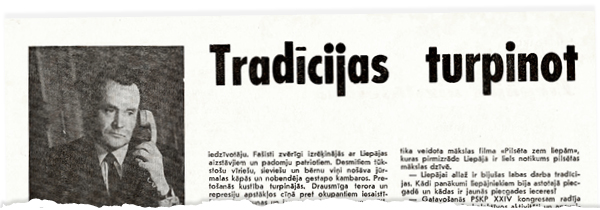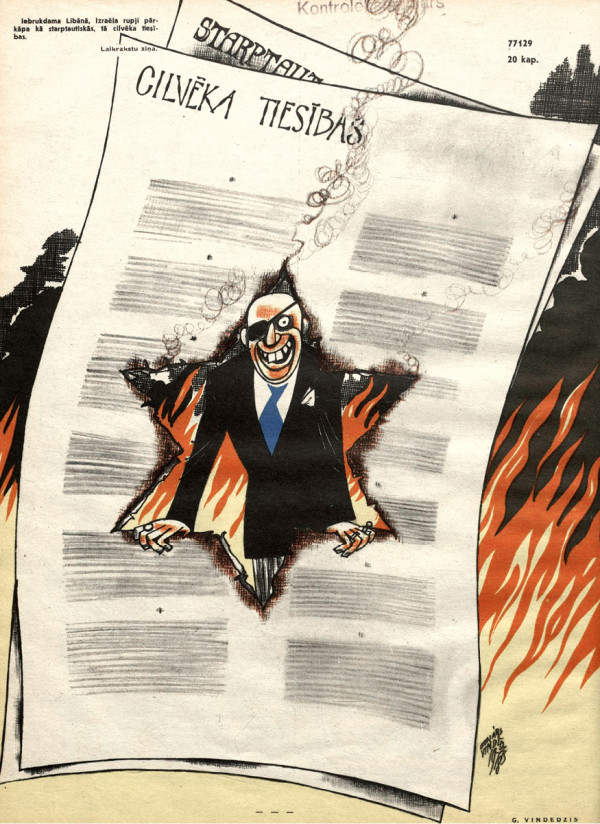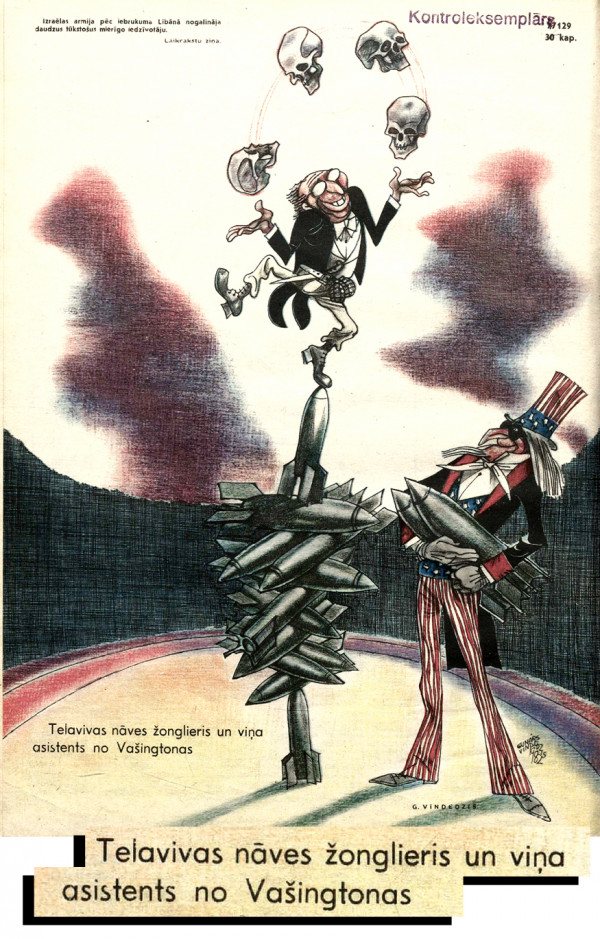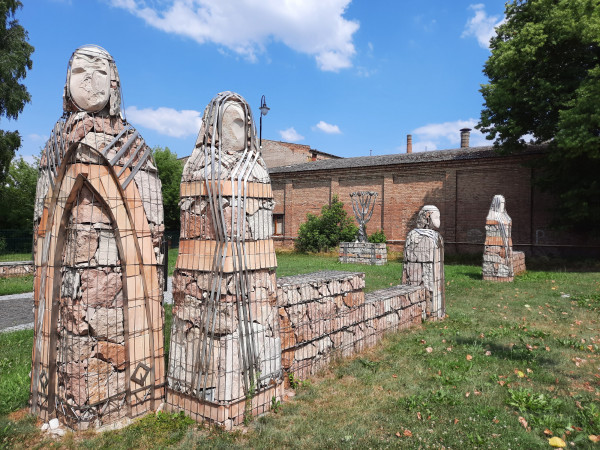How Soviet propaganda hid Jewish corpses
The victims of the Holocaust in Latvia during the Soviet occupation were hidden by pretending the killed Jews were communists and all sorts of others who fell in the summer of 1941 and in the subsequent guerrilla or underground battles against the German invaders.
Throughout the Soviet Union and its constituent part of the Latvian SSR, the killing of Jews could only be mentioned as an exception. It was determined by global geopolitical positioning from the early 1950s to the late 1980s. The Jewish state of Israel, proclaimed in 1948, very soon became one of the main points of support for the United States in the Cold War with the Soviet Union. In turn, a Soviet propaganda cliché was born, calling Israel a dog on the American imperialist chain, and so on. Such an attitude would be significantly weakened by also calling Jews victims, who, moreover, were murdered in such a way that it could not fail to evoke particularly deep sympathy. Therefore, the extermination of the Jews was not denied, but silenced as consistently as possible, so as not to confirm or deny it. One could long analyze the extent to which Israeli affiliation with the United States was influenced by anti-Semitism at all levels of Soviet government, and the extent to which Israeli affiliation with the United States actualized, fueled, and seemingly justified such anti-Semitism.
The specifics of Latvia and the case of Liepāja
The Latvian SSR could not deviate much from the mandatory rules throughout the USSR for the Holocaust (the main thing is not the name, but the historical reality, to which such a designation was later affixed), which in the case of Latvia meant not to go too far in denying the Holocaust. Due to the coincidence of historical events, not mentioning the Holocaust here was a more important part of Soviet propaganda than on average in the large country. Namely, the Soviet occupation regime tried its best to maintain the impression that German invaders had killed tens and maybe even hundreds of thousands of Latvians just for resisting these invaders. With such a number of fighters and - even more impressive, more moving and also more encouraging - fallen fighters, the Soviet regime had to beat the thousands of people who began an uprising against the Soviet regime in June 1941, the moment the German blow shook the regime. That does not mean that people not called into the regular Soviet army would not have fought on the side of the Soviet regime either. There were such fighters, but not in such numbers that it would be possible to substantiate the allegations that not all, but still the Latvian people, had fought against the German invaders. More precisely, the whole nation could not fight the Germans by definition, because there was a fight against bourgeois nationalists, fascist followers, etc. in the list of merits of Soviet patriots. So, they had to be the backdrop for the fights and fighters for the victory of communism. All that matters is that the backdrop does not overshadow these fighters. Tricks were needed to inflate the number of these fighters, which was done at the expense of the Jews killed by the Germans and their local helpers.
In the article in Neatkarīgā of the change of power of the Latvian occupation that took place 80 years ago, special attention has been paid to Liepāja more than once. This has to be done again, because it is precisely in relation to Liepāja that there is an example of presenting the manipulations of Soviet propaganda in the most visible way. At the heart of it all is, of course, the indisputable historical fact of defending the city with such a force that should have warned the Germans that their plans to destroy the Soviet Union in five or six months could end exactly the same way as their plans to occupy Liepāja in five to six hours. In truth, the Germans occupied the city in seven days. Neither this time spent nor, most importantly, the number of victims sacrificed for occupation was in any way part of the original plans of the Germans and caused them anger, a desire to take revenge on at least someone, and so on. As a result, the newspaper "Kurzemes Vārds", renewed under the auspices of the new occupation power, in its first issue on July 2, 1941, wrote an order of the German commander that "Ten hostages will be shot dead for each separate attempted attack, act of sabotage and every robbery for the reassurance of the city of Liepāja and the restoration of normal economic conditions." Was such an order also complied with? Holocaust researcher Andrievs Ezergailis points out that formally yes, because Jews who have been shot by German sea infantry were named hostages. Such a case was not a common practice for the German army, but it is in good agreement with the Soviet side's story about defending Liepāja, that in this battle two German naval battalions lost their commanders and suffered very great losses in general. From today's point of view, such a sentence could be completed in such a way that the damage was probably so great that these battalions could no longer do anything more than shoot the civilians.
The words are mixed and the numbers are exaggerated tenfold
Representatives of the German (you only have to read "Kurzemes Vārds", which is now easily accessible electronically) and the Soviet side agreed that a noticeably large number of Soviet regime employees and supporters had fought together with the Soviet army. How many were there and what happened to these people in the end? As a special arrangement for Soviet propaganda, there was a coincidence between the truly heroic defense of the city and the people actually killed, all of whom were claimed to have been killed in the fight against the Germans. In the most obvious way, such manipulations were carried out exactly fifty years ago, when, as this summer, another big anniversary of the fighting near Liepāja passed. In honor of this anniversary, the magazine "Zvaigzne" sent a correspondent to Liepāja, who was given the opportunity to talk to Jānis Vagris, the first secretary of the Liepāja City Committee of the Communist Party (1930; later the first secretary of the Central Committee of the Latvian Communist Party).

The publication begins with a long introduction, probably written by the same A. Bergs, who wrote down the following direct speech by J. Vagris. The journalist wrote figuratively and flowerily, an already high official in the hierarchy of power at the time confirmed it succinctly:
A. Bergs: - The fascists in the besieged city could not feel safe, the Hitlerites could not break the resistance movement in Liepāja. And only by using the cruelest methods of intimidation of the population, they were able to achieve a partial decline in resistance. It was ordered that up to a hundred peaceful people would be killed for every attack on a German military man under wartime laws. The fascists dealt with the defenders of Liepāja and the Soviet patriots brutally. They shot tens of thousands of men, women and children in the dunes of the seaside and killed them in the Gestapo chambers. The resistance movement continued. In the face of awful terror and repression, more and more resistance groups became involved in the fight against the occupiers. There were underground organizations, diversion groups and Soviet intelligence in the city. Many Liepāja residents fought in guerrilla units, many helped the people's avengers to procure weapons, ammunition, medicine. These are important facts that express the mood and character of Liepāja residents.
J. Vagris: - German fascist invaders and their bourgeois nationalist comrades killed more than 30,000 people in Liepāja. A monument has been erected in the Central Cemetery and in the dunes of Šķēde to commemorate the fallen defenders and the victims of fascism.

Whoever knew nothing about the Holocaust (not the name, but the content) would not have learned that the largest mass of people among those actually killed were Jews, regardless of the fact that most of them had nothing to do with defending Liepāja; and no matter how large a proportion of the Jews killed knew more of German language and culture than Jewish. In 1971, the 30th anniversary of the defense of Liepāja was celebrated, when a shorter time had passed since the event to be commemorated than to the present day. If the Soviet regime had remained and guided its propaganda along the already well-trodden tracks, even for most Latvians, such an interpretation of history would have become an apparent reality. It makes no sense to mention what the whole world would be like in that case, whether the name of the Holocaust would be mentioned in the world, and in which cases the Soviet Union would allow it to resonate on its territory for various tactical reasons, as it sometimes did before the collapse of the Soviet Union.

Analyzing the "Zvaigzne" article in a fancy way with the use of the term "archetype", it is worth noting the tenfold exaggeration, both when indicating the number of hostages determined by the Germans for shooting and the total number of actual victims. It is this exaggeration that characterizes humanity since the first written testimonies it left behind. Namely, historians of various times and places have noted that the ancient chronicles tell everything correctly, as soon as each numerical quantity indicated there is divided by ten. The total number of Jews killed in Kurzeme is estimated at about 5.7 thousand, of which up to three thousand would go to Liepāja with its surrounding county or district. About two thousand Jews have been killed in Jelgava and its surroundings, but that is already Zemgale. Probably, the reference to the 30 thousand people killed is not taken from thin air, but from rough ideas about the losses of Liepāja residents in the 1940s. Talking about Nazi repression and war was also a great pretext for writing off the victims of Soviet repression to the Germans.
Dedicated to the Jews of Bauska
The example with Liepāja represents the current of Soviet propaganda, which did not rule out the possibility of counter-currents, vortices and whirlpools forming in it for a moment. It is a coincidence that in 1971 a monument was unveiled to the killed Jews of Bauska and its surroundings, which could not be attributed to any fight against the German invaders because there were no such fights in Bauska. Immediately after the arrival of German troops in Bauska, the Jews were expelled from the city center to the outskirts (the distance from the center to the outskirts in a small town is about five steps), soon showed into one building with a yard and taken from there to Likvertena forest in Vecsaule parish. There, a Latvian unit, i.e., the “Arāja Team”, who had earned the right to the threatening German letter combination SD (Sicherheitsdienst - Security Service), arrived from Riga and shot about 500-600 Jews from Bauska, its surroundings and also from Jaunjelgava within a few hours. Bauskans, who entered the service of the Nazi regime, could then say that they didn't do anything bad - they were just guarding the Jews, which sounds even good, but well, yes - they also bullied them a little, hit a little - who doesn't?


Bauska was not among the cities where the newspapers closed with the Soviet occupation in 1940 were quickly restored, so no articles were written and printed in Bauska that would blame the Jews for all the deadly sins and call for revenge. "Bauskas Vēstnesis" resumed its publication on January 9, 1942, in order to inform the local population about the orders of the German authorities and to address purely economic issues, in which Jews were represented in the first issue of the newspaper by a local German commander: "Police handed over to the German troops the fur left behind by the Jews. Some fur products are unsuitable for military use. By order of V. K. Mitau, I will sell these fur products (those are 6 ladies' items) at auction on the commandant's office on Saturday, January 10 at 10 am. I will use the proceeds from the sale of these items to turn the donated wool yarn into sweaters for the soldiers.” German troops marching through Bauska had already stopped near Moscow, stuck, frozen and ready to be saved even by Germans selling Jewish clothes.
People who fought for the monument “Human Figures” in Likvertena woods, created by sculptor Imants Murovskis (1925-2001), are not well-known. At that time, everyone in Bauska still understood what is what - what the words at the base of the monument mean without mentioning the Jews: "Eternal memory of the Soviet citizens who were killed in 1941 by the German-fascist occupiers and their accomplices - bourgeois nationalists." With the restoration of the Republic of Latvia, the meaning of these words could be revealed in the public space. In the autumn of 2017, a memorial site (authored by the sculptor Ģirts Burvis (1962)) was unveiled on the site of the Bauska Synagogue, which was burnt down in July 1941, with the historical truth without disguise: "Dedicated to the Jews of Bauska who lived here for centuries and built this city, and who were killed in 1941 by the Nazis and their local helpers."
